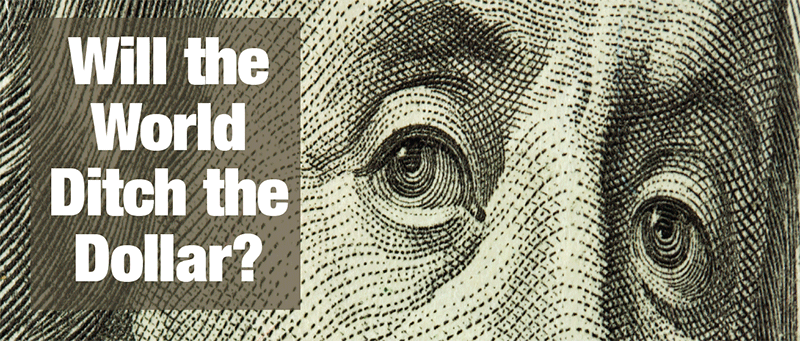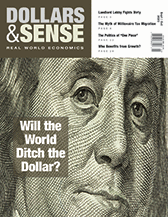
This article is from Dollars & Sense: Real World Economics, available at http://www.dollarsandsense.org
This article is from the
September/October 2023 issue.
War, Empire, and the Global Movement Against U.S. Monetary Hegemony
Download a pdf of this article here.
The U.S. dollar’s dominance in the global economy effectively positions the U.S. government as a middleman in every trade and financial transaction in which the dollar is used. And the dollar is used far more than any other currency in the world. These simple facts underpin many recent debates about “de-dollarization,” the process by which the dollar becomes less dominant in the global economy.
Toward the end of World War II, with much of Europe in ruins, the U.S. dollar was the strongest and most stable currency around. World leaders agreed at a 1944 conference in Bretton Woods, N.H., that the dollar should anchor the global monetary system, providing financial stability as the world recovered and rebuilt. The “Bretton Woods system” that emerged and was fully implemented by 1958 involved a “dollar-gold standard” in which the United States pegged the value of the dollar to gold, and then other countries pegged their own, domestic currencies to the U.S. dollar. The privileged status bestowed upon the dollar at Bretton Woods—what French finance minister Valéry Giscard d’Estaing famously later called an “exorbitant privilege”—has afforded the U.S. government, and the U.S. financial system more broadly, tremendous power over global economic and political affairs, and over the fates and fortunes of people across the globe.
Today, many scholars and pundits maintain that, despite the recent flurry of speculation to the contrary, there is no real threat to the dollar’s dominance. We humbly disagree. The dollar has been dealt a severe blow over the last 18 months owing to the Ukraine war and its surrounding context, a geopolitical shock that disrupted the more comfortable terrain on which the dollar previously rested. The dollar, and to a lesser extent the euro, have become targets of a growing international backlash to Western military, political, and economic dominance since the war began. Part of this backlash involves a wide swath of the non-Western world coordinating to reduce dependence on the U.S. dollar and develop alternatives that permit it to cut out Western monetary middlemen. This is the first time since World War II that so many countries with such combined economic strength have been so unified in their opposition to the U.S. dollar (and to a lesser extent the euro) and so determined in their efforts to establish viable alternatives to its position as an anchor of global financial and trading systems.
In the sections that follow, we first discuss the “old” view of international currencies and contrast it with the “new” view that informs our findings and conclusions. We then discuss global discontent with the dollar, the impact of the Ukraine war on the dollar’s legitimacy and reputation, and the alternative arrangements sprouting up to compete with the dollar in global trade and finance.
Dollarization and De-dollarization in National Context
There are two different but related meanings of “dollarization.” The first is general and broad, referring to the historical dominance (or “hegemony”) of the dollar in the global economy in general, as a medium of exchange, store of value, and unit of account. The second refers to a deliberate, national-level policy to adopt the U.S. dollar instead of using the domestic currency in order to promote macroeconomic stability. The two senses of “dollarization” are related, especially because countries historically stabilized their economies using the dollar precisely because the dollar was already so dominant globally.
Looking more closely at a specific case, Zimbabwe’s recent experiences show how both dollarization and de-dollarization can be motivated by similar economic concerns, as well as how, in practice, countries experiment with different currency arrangements over time to identify strategies and policies that best meet their needs. Zimbabwe dollarized in 2009 to stabilize its economy following years of political upheaval and poor economic management. Zimbabwe’s inflation rate reached its peak in 2008, climbing to 500 billion percent (you read that correctly), rendering the local currency worthless. In 2009, Zimbabwe decided to adopt a multi-currency system, meaning that it began to use foreign countries’ currencies for trade and financial transactions, mostly the U.S. dollar, but also the euro, British pound, Chinese yuan, and South African rand.
While dollarization helped reduce inflation, it led to other problems. A shortage of U.S. dollars developed because everyone was using them, and it became difficult for residents, especially poorer ones, to access the cash they needed for daily transactions. Social unrest followed dollar shortages, as residents struggled to obtain food, health care, and other necessary items. Zimbabwean exports became less competitive as local goods priced in dollars for export appeared to be more expensive on global markets. The government also surrendered its monetary policy autonomy, meaning it could no longer manage the domestic money supply and interest rates because those decisions now rested with the U.S. government following the decision to dollarize.
In 2022, after the value of the U.S. dollar skyrocketed and more dollar shortages erupted, Zimbabwe introduced gold coins in an effort to de-dollarize, i.e., to reduce its reliance on the dollar. The Zimbabwean Central Bank is minting the coins, which are expected to cost around US$1,800 each. John Mangudya, the head of the Reserve Bank of Zimbabwe, believes that the gold coins will help reduce domestic use of the U.S. dollar, “We are now providing that store of value to ensure that people do not run to the parallel market in search for foreign currency to store value.”
De-Dollarization: The Old View and the New View
In a June 2023 interview with Truthout titled “Is the US Dollar on the Verge of Being Dethroned as the World’s Currency?” economist Gerald Epstein noted that, “[O]verall, there is no other currency that plays as many roles in as many places as the U.S. dollar.” In a July article in the New York Times “Debunking De-dollarization,” economist Paul Krugman more or less agreed: “The U.S. dollar is, in a real sense, the money of moneys…”.
Both articles go on to discuss the usual data that come up these days in de-dollarization debates. Despite some modest declines in usage in recent decades, the U.S. dollar in 2022 accounted for roughly 60% of international foreign exchange reserves, 70% of global debt issued in foreign currencies, and was involved in almost 90% of all global foreign exchange transactions. For now, the dollar is just too important and too widely used to be seriously challenged—or so the argument goes.
In his 2015 paper “International Currencies Past, Present, and Future,” economist Barry Eichengreen notes that this position on the dollar’s current and future place in the world—a common one among many contemporary observers—is based on what he calls the “old view” of international currencies. The old view assumes that the international monetary system tends toward monopolization by a single currency with overwhelming strength and power, and that, once dominance has been established, it is difficult to undo. Network effects (which render participation in the dollar’s network more valuable as more users are added, and which make exiting the network more costly) and inertia (the general habit of using the dollar) can maintain a currency’s global dominance much longer than we might think. The transition from one currency regime to another, then, is understood as a cage match in which two superpowers and their respective currencies vie for total world domination, with the winner’s hegemonic currency replacing the loser’s. From this perspective, the dollar is not at risk because there is no other currency capable of supplanting it.
By contrast, what Eichengreen calls the “new view” of international currencies draws on different data and assumptions, resting less on network effects and more on an “open system” model in which a dominant currency can be supplanted more easily than is assumed in the old view and in which several dominant currencies can coexist in the global economy. Eichengreen notes:
Where the old view found support in the dollar’s dominance in the second half of the 20th century, the new view finds support in other periods during which several currencies have simultaneously played consequential international roles. Where the old view implied that the dollar’s dominance might persist for an extended period, the new view predicts that the dollar will have rivals sooner rather than later.
In the context of his study of how the U.S. dollar replaced the British pound sterling as the world’s hegemonic currency, Eichengreen points to “large shocks” and “effective coordination mechanisms” among rivals as factors that can disrupt and undermine the power of a dominant currency. “[E]ven strong lock-in can become unlocked,” Eichengreen wrote with Marc Flandreu in 2008, “Evidently inertia is less than sometimes supposed.”
Eichengreen has noted that there are generally two conditions that must be met for a globally “hegemonic” currency like the U.S. dollar to lose its dominant status and start facing real competition. First, there must be a “negative shock” that affects “the reputation of the incumbent.” Second, there must be “positive steps”…
Read More:Will the World Ditch the Dollar?
2023-09-30 14:59:48

